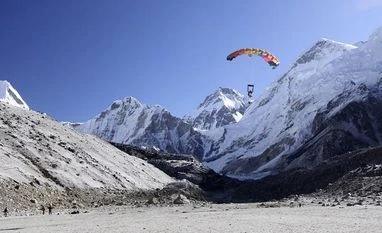Most traffic jams are just annoying, but when they happen near the summit of Mount Everest’s 29,029-foot peak, they can be deadly. Eleven people died this season after a mix of erratic weather, a record-breaking number of permits and widespread inexperience caused an hours-long queue at the “top of the world.”
But what if there were an alternative way to experience the world’s tallest mountain? Perhaps by hurtling yourself down an empty route at over 130 mph, with nothing but air beneath your feet, an oxygen mask across your face, and the snow-capped Himalayas around you on all sides?
Every November, the Everest Skydive expedition offers one of the highest commercial freefall experiences in the world. Starting at $25,000, guests are guided on an 11-day trek through Nepal that wraps with two tandem skydives from more than 23,000 feet above sea level (AMSL). “The exhilaration of jumping into the Himalayas is unrivaled,” says Tom Noonan, executive director of Everest Skydive. The freefall is matched only by the parachute ride that flies you past the natural wonder as only bar-headed geese on a Himalayan migration can.
A typical recreational skydive is made from 10,000 to 14,000 feet AMSL. Few civilian drop zones offer trips higher than 18,000 feet in the US, and only one — SkyDance, in Davis, California—is approved by the Federal Aviation Administration to allow oxygen-supplemented jumps from above 28,000 feet. (That one will run you $3,000, although the views of California’s central valley may not quite compare.)
The skydiving surge
Skydiving has seen a boost in popularity since the days of round canopies and combat boots. The sport reached the masses with the advent of the tandem parachute system in the early ‘80s, received a push from the 1991 film Point Break, and then had a breakthrough in the age of social media. The United States Parachute Association (USPA), the sport’s domestic governing body, issued more than 4,200 new basic skydiving licences in 2018 and now has the highest membership levels in its 72-year history.
Mountaineering experienced a similar trajectory in growth. The allure of conquering the least hospitable reaches of nature led to the commercialisation of Everest in the ‘90s. The following decades brought an influx of people making the trophy-hunting pilgrimage. With the rise of the local low-cost operators that set out to undercut foreign competitors came many unseasoned climbers.
Of the 381 permits Nepal issued in 2019, “about 50 per cent shouldn’t have been on the mountain,” says Alan Arnette, a mountaineer and Everest chronicler. This year, the median price for the two-month climb was around $45,000, though some outfits offered treks for as little as $28,000. In August, as a response to the deadly bottlenecks, Nepal proposed a plan to cut down on permits by placing a $35,000 minimum charge on operators. Climbers must now also submit proof of having summited at least one 21,300-foot peak before testing Everest.
Everest Skydive is in its 12th year of operation and Noonan estimates that he’s made nearly 200 jumps in Nepal. For the former retirement planner turned skydiving industry guru, those are just a small fraction of his 8,000-plus jump logbook. But he’s not the only accomplished jumper in camp. His team consists of several world-record-holding skydivers and aims to allocate one staff member to each guest.
How it works
Guests arrive in Kathmandu and start their trip with sightseeing tours that double as acclimating days. Then they board a puddle-jumping flight to one of the world’s most dangerous landing strips: Lukla Airport. At over 9,300 feet AMSL, Lukla’s 1,729-foot runway sits between a mountain-sized rock and the abyss. “It’s the closest thing to landing on an aircraft carrier I can think of,” says Noonan, a pilot himself. “These pilots are some of the best I’ve ever met.”
The lead-up to the jumps involves further trekking and acclimatisation as they head to Namche Bazaar at 11,286 feet AMSL. As part of the cost, the crew provides all the services and luxury accommodations along the trails through partnerships they’ve developed in the region.
The biggest expense and logistical obstacle comes from transporting a functional skydiving drop zone to the Syangboche airport, a 1,200-foot dirt airstrip at 12,340 feet AMSL, or the even higher Ama Dablam Base Camp, at 15,000 feet. Nearly 2,000 pounds of equipment must be moved up the mountain. On jump day, guests and instructors board the AS350 B3 helicopter and start the 15-minute ascent up the Himalayas.
The group had previously used a Pilatus PC-6 fixed-wing aircraft, but the B3 allows for easier navigation in spite of a shorter service ceiling. For guests, the rotary-wing is better for its scenic capabilities, offering an intimate exposure to the mountains. At times, rock faces are a mere 100 feet away.
Then there’s the jump. Freefall lasts 40 seconds; descent slows at approximately 19,000 feet AMSL, once the parachute deploys overhead.
Unlock 30+ premium stories daily hand-picked by our editors, across devices on browser and app.
Pick your 5 favourite companies, get a daily email with all news updates on them.
Full access to our intuitive epaper - clip, save, share articles from any device; newspaper archives from 2006.
Preferential invites to Business Standard events.
Curated newsletters on markets, personal finance, policy & politics, start-ups, technology, and more.
)